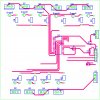I am about to launch a product dedicated to this specifically for WiFi control of LED lighting solutions up to 5 A per LED string.
Each 2.75 " square weatherproof module runs on an IoT processor and delivers 8 monochrome channels of 8 to 16V, 5A switching for full PWM effects. Thus one module can drive 2 RGBW strings for full color gamut.
Sequencing of complex effects is done by the freeware Vixen 2.0 software sequencer, downloaded via USB to a master control and relayed via wifi to all addressed 8 Channel LED modules. The master controller (Wifi) triggers the sequences based on a battery backed RTC START/STOP timer or Photocell.
The system 'remembers' the vixen 2.0 sequence and is independent of a PC linkup. The modules use very low bandwidth protocols, custom developed for this app. They are designed to run up to 25 second sequences of up to 1600 LED instructions with persistence until different PWM instruction is required. The instructions are vector instructions which direct the PWM to a target value over a target time frame. 100mS time stepping.
Multiple Modules can be run standalone without Wifi and remain in decent sync over a few hours once they are powered up simultaneously.
There's a video of it in action lower down on this project page:
https://hackaday.io/project/19458-dlight-displays
Vixen 2.0 sequencer:
https://www.vixenlights.com/downloads/vixen-2-downloads/




